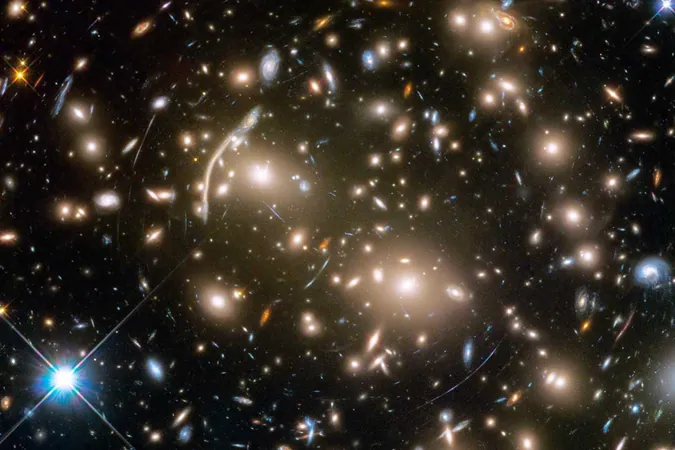
Revolutionary Discovery: The First ‘Einstein Zig-Zag’ in Space Could Unravel the Mystery of the Universe's Expansion!
2024-11-15
Author: Chun
Revolutionary Discovery: The First ‘Einstein Zig-Zag’ in Space Could Unravel the Mystery of the Universe's Expansion!
In a groundbreaking revelation, astronomers have identified an extraordinary phenomenon in the cosmos known as the ‘Einstein Zig-Zag.’ This rare gravitational lens, designated J1721+8842, challenges our understanding of light phenomena in the universe and may hold the keys to solving the longstanding mystery of the universe's expansion.
Initially discovered in 2017, J1721+8842 was thought to be a traditional gravitational lens where a galaxy bends light from a distant quasar, an energetic galactic core. However, after two years of intensive observations utilizing the Nordic Optical Telescope, coupled with advanced data from the James Webb Space Telescope, a team of researchers has confirmed that this system is actually a compound lens composed of two aligned galaxies. Remarkably, the light traversing this lens is not straight but follows a zig-zag pattern, marking the first instance of an ‘Einstein Zig-Zag’ lens in recorded history.
The researchers, whose findings can be found on arXiv, elaborated, “Our observations, supported by light curves from the Nordic Optical Telescope and redshift measurements from the James Webb Space Telescope, unequivocally confirm that a single light source is lensed in J1721+8842.” This development is not only significant for the study of gravitational lenses but also opens new avenues for exploring fundamental cosmic questions.
Gravitational lenses have long been recognized for their ability to amplify distant light that might otherwise remain hidden. These natural cosmic magnifying glasses allow astronomers to observe ancient and far-off regions of the universe. Notably, last year, such lenses helped locate Earendel, the oldest known star, illustrating their immense value.
In astronomy, these lenses frequently create stunning visual phenomena known as Einstein rings. A previous study speculated that these rings might bolster evidence for axions, hypothetical particles that could explain the mystery of dark matter, which constitutes 27% of the universe yet remains undetectable.
Earlier this year, researchers from the Lawrence Berkeley National Laboratory unveiled a sophisticated gravitational lens they likened to “eight needles precisely lined up” in a haystack. This remarkable discovery included an Einstein Cross, which demonstrated the symmetrical distribution of mass within the lens, including the elusive dark matter.
However, the unique configuration of J1721+8842 sets it apart from its predecessors. The zigzagging trajectory of light through this compound lens paves the way for new insights into the Hubble constant—the vital number that quantifies the rate of the universe's expansion. Notably, discrepancies in the measurements of this constant have led to what is known as the Hubble tension, a baffling inconsistency that puzzles astronomers.
The future of this research looks promising. The team revealed that full lens models and time-delay measurements derived from J1721+8842 would be published in upcoming papers, enhancing our understanding of cosmic expansion. These insights will help astronomers ascertain whether findings align with established cosmological models and offer a clearer view of the universe's evolutionary history.
As we delve deeper into these celestial mysteries, the power of state-of-the-art telescopes continues to astound, revealing answers to some of humanity's most profound questions, such as the origins of the universe and its ultimate fate. The discovery of the Einstein Zig-Zag is not merely a curiosity; it represents a significant milestone in our quest to know what lies beyond and how everything interconnects in the vast cosmic tapestry.
So, buckle up, space enthusiasts! The discovery of J1721+8842 is not just cool—it’s a potential game-changer in our understanding of the universe!




 Brasil (PT)
Brasil (PT)
 Canada (EN)
Canada (EN)
 Chile (ES)
Chile (ES)
 España (ES)
España (ES)
 France (FR)
France (FR)
 Hong Kong (EN)
Hong Kong (EN)
 Italia (IT)
Italia (IT)
 日本 (JA)
日本 (JA)
 Magyarország (HU)
Magyarország (HU)
 Norge (NO)
Norge (NO)
 Polska (PL)
Polska (PL)
 Schweiz (DE)
Schweiz (DE)
 Singapore (EN)
Singapore (EN)
 Sverige (SV)
Sverige (SV)
 Suomi (FI)
Suomi (FI)
 Türkiye (TR)
Türkiye (TR)